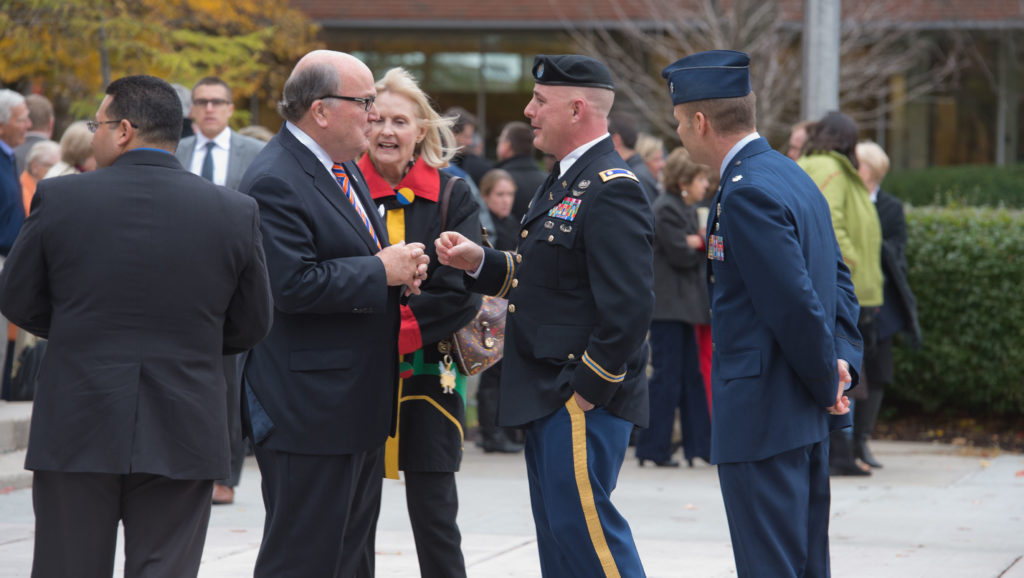Job hunting isn’t fun, and if you’re just transitioning from military service, it’s probably been a while since you looked at your resume. The bad news is, it’s much worse than you think. The entire hiring landscape has shifted since you swore an oath. That said, the veteran unemployment rate is still lower than the national average. Check out the D’Aniello Institute for Veterans and Military Families’ (IVMF) ongoing research into veteran employment.
Modern hiring practices place daunting obstacles between veterans, active-duty personnel, and military spouses and their dream job. It can feel like you’ve sent out hundreds of resumes into the void for jobs you know you’re qualified, or even over-qualified for, and you just aren’t hearing anything back. A month or two of job hunting can have you questioning your decision to separate.
The problem isn’t you, so much as being unaware of just exactly what you’re up against. Let’s talk about the barriers between you and that dream job, and get you started on some ideas to overcome them and find success.
Problem 1: Automation in Hiring
 The COVID-19 pandemic killed the office and gave rise to remote work. No longer limited to local talent, companies can recruit nationwide (or even worldwide) to increase the candidate pool a thousand for each position. Recruiters and HR reps aren’t always going through all those candidates by hand, so in many cases software algorithms narrow the candidate pool from hundreds or thousands to just a few top choices.
The COVID-19 pandemic killed the office and gave rise to remote work. No longer limited to local talent, companies can recruit nationwide (or even worldwide) to increase the candidate pool a thousand for each position. Recruiters and HR reps aren’t always going through all those candidates by hand, so in many cases software algorithms narrow the candidate pool from hundreds or thousands to just a few top choices.
If your resume isn’t triggering their Applicant Tracking Software (ATS), at some companies, no human ever lays eyes on it.
This technology is new, but it’s already everywhere. According to a Jobscan report, 487 of Fortune 500 companies (99%) are using an established ATS, mostly Workday (38.5% market share), but also SuccessFactors (15.1%), Taleo (8.4%), ICIMS (7.7%), Oracle (5.3%), or Phenom People (4.7%). Greenhouse and Lever are also very popular outside Fortune 500 companies. The 13 Fortune 500 companies that aren’t using an established ATS? They’re probably using proprietary software the Jobscan report just didn’t detect.
But what about the other 33.2 million companies in the United States? Well, 66% of large companies and 35% of small companies also use an ATS. Those companies without an ATS often instead rely on recruiters and headhunters, who have their own ATS software.
Granted, how each company uses the ATS can vary. Some use it as a backstop to supplement their HR departments, while others rely on it to make early cuts to the applicant pile. This way their HR people have fewer, but more qualified, candidates to choose from.
What To Do About It
It doesn’t matter how well you interview if you can’t secure an interview. You absolutely must learn how to “sell” your resume to an ATS. At IVMF, our own Onward to Opportunity (O2O) program, in association with Hire Heroes USA, helps participants optimize their resume. You’ll learn how to take advantage of ATS software and give yourself the best chance of securing an interview for your dream job, particularly in customer service, information technology, or business management fields.
But ultimately, there are two things to do about the barrier ATS systems can put in your way. The first strategy is to spend time at events where you can make a personal connection ahead of submitting a resume. Job fairs, hiring events, and the like are great opportunities to get in front of the HR people and make an impression ahead of submitting, so they’re actively looking for your resume when you send it.
The other strategy is to update your resume, ensuring you use all the keywords in the job posting in your document, and connect those keywords to relevant job experiences. This means crafting and reworking your resume each time you submit to a job posting. It’s a lot of extra work
Fix Your Formatting
Updating your resume starts with making sure an ATS can actually read it. Strange fonts, formatting, and tables can make it more difficult for an ATS to read your resume and extract the right information. This can lead to getting shuffled into a different pile, or even being rejected out of hand. There are a variety of tips for optimizing your resume to beat an ATS, we like what Jobscan has to say on the subject.
A variety of generative AI tools are also getting better and better at resume building. Teal, Enhancv, Kickresume, Resume Worded, and ResumeNerd are all viable options with free plans and paid plans to keep up with the demand of tailoring your applications to different positions. Just remember to double check the work before submitting! Generative AI still makes mistakes, and you want your resume to be accurate.
Problem 2: Translating Your Skills
 What you did for the military in your 20s is more real-life work experience than almost anyone in that age group has. The responsibility and op tempo the US military puts on a 23-year-old with no college education is almost unreal compared to the same experiences that age group has in the private sector. You need to leverage that in a way that speaks the language of hiring professionals both in your resume and while interviewing.
What you did for the military in your 20s is more real-life work experience than almost anyone in that age group has. The responsibility and op tempo the US military puts on a 23-year-old with no college education is almost unreal compared to the same experiences that age group has in the private sector. You need to leverage that in a way that speaks the language of hiring professionals both in your resume and while interviewing.
Military slang, jargon, and acronyms don’t mean anything to civilians. They don’t know the difference between a Good Conduct ribbon, a campaign ribbon, and the Silver Star. They don’t know what a 4.5 eval average means. They don’t understand how your experience can be an asset to the company. You need to find a way to explain that without resorting to language only other military personnel can understand.
Bottom line, civilians don’t really understand what military personnel do.
Most of them can’t even fathom it. So, you don’t get to just apply for a job listing your work experience, you also must teach them what that experience is and how it could translate to their company.
What To Do About It
Find a way to speak their language. The keys to translating your skills are to remove as much military jargon and acronyms as possible and use as many hard numbers as possible (even if you have to look them up). That means when you say you worked at PSD Norfolk as a Personnel Specialist, most HR professionals have no idea what that means. However, if you say you handled payroll, travel, and human resources administration for the world’s largest Naval Base, serving 82,000 uniformed employees, they know exactly what that means, and none of their other applicants are going to have that experience.
Think about your big achievements in the same way. If you earned a medal or letter of commendation for a project, speak about the accomplishment without relying on military jargon and focus on the numbers. Numbers that focus on end-users/customers, percentage increases, dollar values for material under your area of responsibility, etc., are all very impressive, and translate well to the corporate world.
If you’re applying for a job that isn’t a civilian equivalent to your military role, focus on your soft skills like leadership, discipline, and teamwork. If you used to oversee ordnance, but you’re applying to be an IT professional? Well, most HR professionals just won’t see how that transfers to their company. Find a way to talk about those experiences in terms of soft skills.
In the military we learn to work with people from all backgrounds and beliefs, we learn to prioritize shared mission objectives to benefit the organization. We learn not just to lead, but also how to follow and support our leaders to achieve the organization’s key objectives. And we are used to doing it all under some of the most high-pressure, chaotic crisis environments imaginable. And when we’re doing all that, we’re maintaining military bearing, something the civilian world just calls professionalism.
Being able to highlight all of that as elements of your military experience makes sure that those experiences stand out to hiring professionals that want you on their team.
Problem 3: Veteran Culture Concerns
The civilian/military divide is greater than it’s ever been. That means the average civilian knows less about what skills veterans bring to the table than ever, and rely on movies and the media to tell them what military personnel and veterans are like. This forms a bias among some hiring managers that you need to overcome.
Some of the most commonly held beliefs include:
- Believing you are a violence risk because of Post-Traumatic Stress
- Believing you’re a bad culture fit because you’re too abrasive or stiff for their employees or customers
- Believing you expect or feel entitled to walk into a role with responsibility equivalent to your last military position
Obviously, these are overblown or untrue, but there’s a chance anything you say might be a red flag for them. And triggering that bias might just get you rejected out of hand. That means that in the limited space of a resume and/or an interview, you must find a way to not just sell your skills as having value to the organization, but also convince them you aren’t a threat or a net negative for their business and put them at ease.
What To Do About It
Try to look at things from your hiring manager’s eyes. Consider their potential biases. You need to make sure you don’t play into those stereotypes, which means making sure you don’t say some things, and do say some others.
Stay away from:
Dark humor: the dry, gallows humor might play well in the barracks, but it freaks civilians out and makes them think you’re a bad day away from shooting up the place. Save this for your closest coworkers after they get to know you better, not as an icebreaker for the interview.
Military Bearing: You being at a 10 out of 10 military bearing for the hiring manager or CEO is probably meant as a show of respect from you, but it just makes you seem overly formal and rigid, or even dangerous. Try and think of these people as your future team leader, not your future commanding officer. That’s about the level of military bearing civilians are comfortable with. Smile more, laugh more easily, and try to be at ease and relaxed. No barking or knife-handing. Don’t answer questions defensively or aggressively. Be as friendly and non-threatening as possible while still being yourself.
War Stories: Civilians will react with horror, shock, or disgust at what most military personnel consider the best war stories. And while that might delight some veterans, it generally won’t get you the job. Save these for your friends. Civilians don’t want to hear about death, hazing, and other forms of suffering from a job interviewee.
Instead, Move Toward:
Being Approachable and Friendly: Don’t stare or glare. Stay engaged and make normal, regular amounts of eye contact. Don’t realign your gig line mid-interview. Don’t attack the company you’re trying to work for to demonstrate your attention to detail unless directly prompted. Don’t get defensive if asked a difficult or uncomfortable (but still professional) question. Instead, smile more. Laugh more when appropriate. Be the warmest, kindest, cuddliest golden retriever puppy version of yourself you can be within the bounds of being professional.
Telling a Story of Leadership: Have a story or two pre-approved by a civilian friend as “job interview friendly” that demonstrates when you showed leadership or did something else to overcome a challenge. These are incredibly common questions in interviews. Having one you can tell just as well as your most disgusting story about being in the field is going to serve you well in the job-hunting process.
Being Excited for the Opportunity: Try to summon some excitement for the opportunity to start this new chapter of your life, especially if it’s your first job after military service. Let them hear you acknowledge that you realize this is starting a new chapter in your professional life, and that you know you have to prove yourself and work your way back up the metaphorical ranks.
Is Your Career Ready for Civilian Life?
Onward to Opportunity is IVMF’s premiere career training program for military personnel, veterans, and military spouses interested in customer service, business management, and IT professional careers. It features both virtual and in-person training at sixteen locations across the United States to help you gain any of over 30 different professional certifications, including Google Cybersecurity Certification, at no cost, and gain access to a wealth of job seeking training, coaching, and advice, as well as hiring opportunities. Learn more and apply to move your civilian career forward today!


